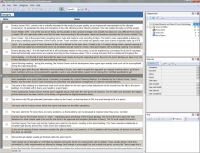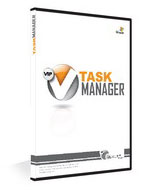|
Task Management Software |
 |
|
|
|
|
| |
|
 TESTIMONIALS TESTIMONIALS
|
|
"...This is an excellent program. I'm so glad that I stumbled on to this when researching for task management programs. Very low learning curv, quite flexible, and the price is right. Tried at least 20 other programs, either too complicated, too expensive, or poor documentation..."
Chad Lindsey -
Honolulu, HI
|
|
|
|
|
|
|
|
Scrum Checklist |
|
|
|
|
|
|

 |
This Scrum Checklist is an overview that can be used to learn this famous agile methodology of project management, which is widely and effectively used in software development (and also in many other industries as well). This checklist explains the basics such as roles, essentials of the workflow of this method (actions to complete on every Sprint and Daily agenda), etc.
|
| Order 750 checklists in MS Word and PDF printable format at $49.99 USD only. |
BUY NOW!  |
Scrum Methodology:
- Product Owner (PO) – person who is critically interested in the product’s proper quality, as an empowered representative of the ultimate consumer(s). He possesses the idea and conception of how the ultimate product should work/look. This role resides formally out of the project team, but the Product Owner collaborates with it closely, intensively and regularly. He mainly leads the development process by communicating his vision and requirements to the team, maintains the acceptance criteria (Definition of Done), negotiates and prioritizes work reasoning from the Business Value it will generate;
- Scrum Master (SM) – one of the key roles, as this position is like a project manager (but actually his duties are very different from ones of a classic PM) who rigorously makes sure that his team lives according to the principles, values and practices promoted by the method. The Scrum Master’s role is not a team leader as well (as the team is self-organizing), but he acts rather as the team’s protector against any distracting influences, and as a keeper of rules. This role mainly assumes a number of buffering and facilitating functions;
- Scrum Team – this is the project team accepting rules and ready to work according to them. The team’s main responsibility is delivering the product satisfying requirements of the Product Owner. Team members not locked into specific roles Such a team is typically made up of 5–9 people with cross-functional skills; larger teams can be formed up of a number of such smaller units (team of teams);
- Sprint – it is a preset period of time (duration of this unit is defined by the team once, it tends to be 1-4 weeks) during which a specific amount of work (definitely stated and constrained) has to be completed and got ready for review. Each sprint begins with a planning meeting. The duration of a sprint is suggested by the SM;
- Product Backlog (PBL) – it is the high-level list of all functionality desired in the product. It can be explained as a prioritized to-do list of requested features/functionality where items are ordered according to their business values. This is a living document that is maintained throughout the entire project. Product Backlog is owned and managed by the Product Owner (he is responsible for updating and prioritizing the Product Backlog items), but it is available to all interested parties and anyone can contribute to it (through the PO). It works like an engine of the project, while the most of the items that are recorded into the Product Backlog are business driven rather than technology driven. PB contains stories, not tasks;
- Sprint Backlog – it is the list of work items that the team must resolve during the impending sprint. Items for the Sprint Backlog are taken from the Product Backlog (in a result of each sprint planning meeting);
- Sprint Planning meeting – during this meeting, the Product Owner and the development team agree upon exactly what work will be accomplished during the impending sprint;
- In order to get a team that can effectively work according to Scrum, you need to engraft this approach as a special working culture, so all your team members who are not accustomed to operate in such a way should obtain a good training from certified specialists to get well-familiarized with this technique which can appear quite difficult for the beginners;
Workflow:
- Every Sprint:
- Each repeatable work cycle (called sprint or iteration) is preceded by a Sprint Planning Meeting: it is attended by the Product Owner, Scrum Master, and the entire Scrum Team (including any interested and appropriate management or customer representatives);
- The point of this meeting is to determine what work will be taken for the new sprint (what tasks/items will be moved from the PBL to the Sprint Backlog). It is limited with 8 hours, and results in a sprint plan;
- At the meeting the Product Owner and the team negotiate about what tasks the next sprint will embrace. The PO offers and describes the highest priority features to the team (which, as he thinks, will generate the highest business value);
- Top items in the PBL get estimated (estimates written by the Team), so that top items in PBL are small enough to fit in a sprint;
- The team and the Product Owner define the Sprint Goal based on the effort estimation;
- The team alerts the PO when there are some problems, so that problems can be discussed & resolved when they occur, not later;
- (1st four hours): the Product Owner vs. Team – negotiating about prioritizing of the Product Backlog. The PO and the team agree the final statement on what criteria need to be met for the work to be approved and accepted (Definition of Done). The PO must respect the team’s established velocity – a metric used to control how much work the team can accomplish in a single sprint (Velocity is written down after each sprint, and it only includes stories that are done according to DoD);
- (2nd four hours): the Team only format: hashing out a plan for the Sprint, resulting in the Sprint Backlog. The Team members collaborate to complete high-priority stories first. Team knows and respects DoD;
- In the end of meeting all team members consider the plan is realistic, and commit to it. PO is satisfied with the priorities, all stories in the Sprint Plan have an estimate;
- Stories that get started usually get finished within the same Sprint;
- Team should be not disrupted or controlled by outsiders during the Sprint (no requirements can be added). Team usually delivers what they committed to, while requirements are allowed to change (and change is encouraged) but only outside the sprint, as once the Team jumps into a new sprint it remains strongly focused on the goal of that sprint;
- During the Sprint the SM maintains the sprint backlog by updating it to reflect which tasks are completed and how long the team thinks it will take to complete those that are not yet done;
- The Sprint Backlog is very commonly maintained as a spreadsheet in Excel, but it is also possible to use any other software designed specifically for this methodology or agile. As an example of tools we can name VIP Task Manager that is not specifically designed, but can serve this methodology;
- Every Day:
- Each day during the sprint, a project status meeting occurs (max 15 minutes). Same time, same place every day, all team members present (SM sits with the team);
- The daily meeting helps the team to organize itself. The PO participates at least a few times per week;
- The daily meeting should be started and ended on time. All meetings should adhere to a common standard. These basic rules not only increase the efficiency of the meetings but also make them more satisfying for all participants;
- Everybody answers the 3 questions:
- What did you do yesterday? (What have you done since yesterday’s meeting?)
- What will you do today?
- What is blocking progress? (What obstacles do you need to get removed?)
- Every team member is aware of what the others are doing. Team members are pulling tasks, rather than SM pushing tasks. Team members address each other, not the SM;
- The Sprint backlog should be updated as necessary to keep the sprint on schedule (Stories are added / removed);
- The Product Owner should be notified of these changes;
- Team maintains a sprint burndown chart that is updated daily. It should be highly visible as it demonstrates the amount of work remaining;
- Problems & impediments should be solved or reported to the PO and/or Chief of development. Any impediments that are raised become the SM’s responsibility to be resolved as quicklyas possible;
- End of Sprint:
- An open Sprint demo should be arranged. Do a Sprint retrospective with the whole team and PO, engage all key persons to spread lessons learned. Demo is the time when the developers get to show everyone all the value they are delivering, and it is an opportunity for the Team to show that their...
| Order 750 checklists in MS Word and PDF printable format at $49.99 USD only. |
BUY NOW!  |
|





 |
CentriQS Tasks Management Solution 
Looking for multi-user task management software? Try CentriQS complete task management solution for planning, tracking and reporting tasks, projects, and schedules. Increase productivity of your small business or office by better organizing your employees' tasks and time.
 FREE Download CentriQS FREE Download CentriQS
|
|
|
|
|
|
|
|
|
|
CentriQS  -15% OFF -15% OFF |
All-in-one business management software
for small and midsize enterprises |
 |
|
|
| VIP Task Manager |
Multi-user project management software
to plan, schedule and track project tasks. |
 |
|
|
| VIP Checklists
|
More than 750 ready-to-use to-do lists
to plan your personal and business life |
 |
|
|
| VIP Team To Do List |
Professional task management software
to make and send team todo lists by email |
 |
|
|
| VIP Organizer |
Personal time management software
to organize time at home and at work |
 |
|
|
| VIP Simple To Do List
|
Simple and effective to-do list software
to plan daily chores, trips, wedding, etc. |
 |
|
|
|
|
|
|
|